Similar to many other ancient villages in the lowland areas of the North, Nom village in Dai Dong, Hung Yen still retains its ancient and quiet beauty, from the communal house, the village pond, the village road, and 19 family temples symbolizing the people of Nom village. In everyday life, mentioning Nom immediately evokes the village's special profession, which is scrap metal trading. That profession "sneaks" into poems, specifically identifying the village: "Scrap metal then returns to Nom bridge".
Going back in history, learning about the formation of Nom village through the remaining communal house relics, we know that the village's tutelary god is Saint Tam Giang - a glorious national hero who fought against foreign invaders and had nothing to do with the scrap metal trade. In the lowland areas of the North, Saint Tam Giang has two incarnations: an angel and a human god. From the angel's perspective, he is a god who protects the river region. As a human god, Saint Tam Giang is a brave general who fought against foreign invaders. After sacrificing his life for the country, he was worshiped by the people. Statistics show that there are nearly 400 communal houses, temples, and shrines in the ancient villages in the North that worship Saint Tam Giang.
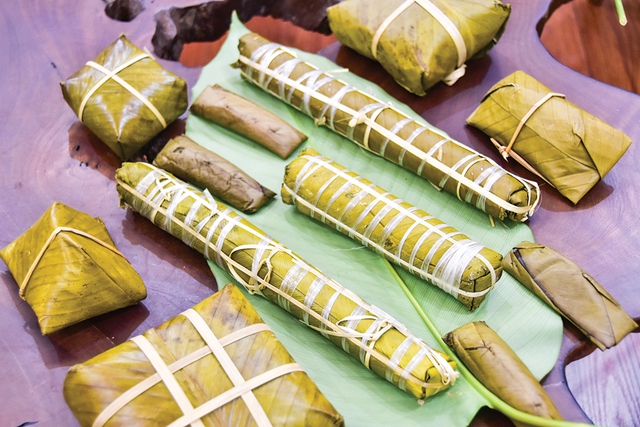
Tay cake has a different length and size than other types of leaf cake.
PHOTO: LAM PHONG
In the Tam Giang communal house relic complex in Nom village, in addition to the ancient architecture of the communal house, tiled roof, stone bridge... there is also an ancient banyan tree. The elders say that this is where the Tam Giang saint and soldiers used to tie their horses and recruit soldiers to fight against the enemy. The recruitment of soldiers was everywhere, each with a different surname. When the country was at peace, many of them stayed and became residents of Nom village. That is why there are 19 different clans here.
Also from the story of the Tam Giang Saint's military recruitment, the Tay cake was born. With a length of nearly 40 cm, the mouth is only as big as 3 fingers put together, very comfortable to hold, each cake is enough for a normal person to eat. The invention of Tay cake by the Nom villagers was to serve the needs of soldiers' food, providing enough nutrients while meeting the convenience, easy to transport, and long-term storage. Thanks to that, Tay cake is a type of food for soldiers to nourish themselves in fierce battles or long marches.
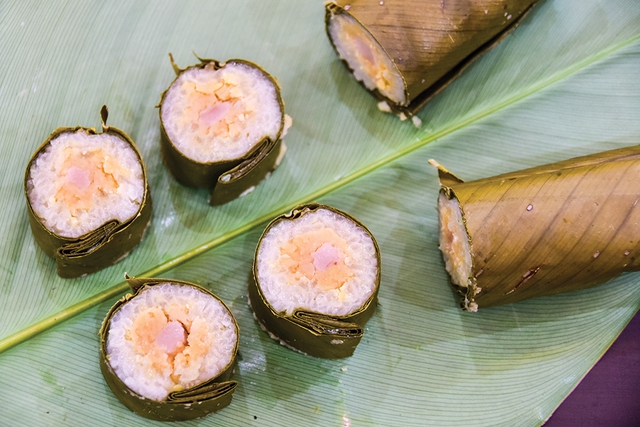
Slice the banh tay with even layers of fat, filling, and crust.
PHOTO: LAM PHONG
The name “banh tay”, when researched, also brings many interesting explanations. Does the cake have any relation to the Tay ethnic group? If we look back at the list of existing families in Nom village and the common Tay family names such as Do, Le, Ta… we can see the similarities. Who knows, during the process of recruiting soldiers, the Tay warriors also participated in the national defense, joined the Tam Giang holy army and brought the typical leaf cake of their people into military life?
Another explanation related to the banh tay comes from the length of the cake. If you measure the average length of a banh tay, it will be equivalent to the length of a forearm with the starting point being the palm and the ending point being the elbow. In the Northern dialect, especially the residents of Ha Tay, the word "tay" when pronounced will be emphasized with a grave accent to become "tay". During the process of gathering soldiers to Nom village, there may have been soldiers from Ha Tay, the change in the dialect caused the banh tay to become banh tay when pronounced.
Back in peacetime, Banh Tay from Nom village was only made during Tet or really important events. The structure of a cake is very simple, just with beaten green beans (peeled green beans, boiled, stir-fried with sugar in a 1:1 ratio) and long-cut pork fat. These two ingredients are used as the filling, while the cake crust is made of sticky rice, covered with dong leaves. Banh Tay, the appearance is simple like that. But when eaten, Banh Tay really impresses with the harmonious balance between ingredients and flavors. The sweetness of beans, the richness of fat, the softness and aroma of sticky rice..., all blend together in each bite, very suitable thanks to the size different from the existing types of Banh La.
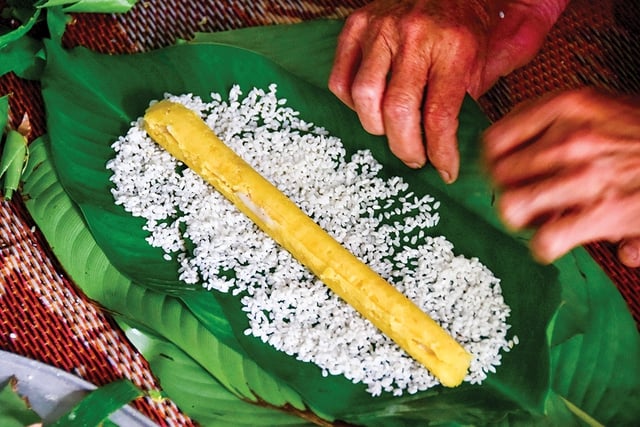
The process of spreading the filling and the cake crust before wrapping
PHOTO: LAM PHONG
As a specialty of Nom village, everyone who eats it praises its deliciousness, but finding someone to make banh tay today is a difficult task when the whole village only has Mr. Ta Dinh Hung who still wraps banh tay every year during Tet. Joining Mr. Hung on a banh tay wrapping trip, listening to the explanation and witnessing the cake making process, we can see that behind the simplicity of the small cake are countless complicated steps. First is dividing the proportions of the ingredients, to make a batch of 100 cakes, we need 10 kg of new-crop yellow sticky rice, 10 kg of white sugar, 10 kg of peeled green beans, and 10 kg of loin fat. In the preparation of the ingredients, only the beaten green beans are laborious because we have to boil the beans until they are soft, beat them until they are no longer shaped like grains, then mix in the sugar and stir well. The hard part is when the beans are mixed with sugar, if you do not stir quickly and evenly, the sugar will melt and burn, and that batch of filling is considered a failure. Stir the beans until they are well-cooked and golden brown to complete the process.
Comparing making banh tay and banh chung, Mr. Ta Dinh Hung said: "Making banh tay is much harder than banh chung, banh chung has a mold, I only need 2 minutes at the slowest to make one cake, and wrapping one banh tay is equivalent to wrapping 3-4 banh chung". When asking the banh tay vendors at Nom market about making banh tay, everyone shook their heads: "No, it's too much work". That hard work, it turns out, is not difficult in the preparation of ingredients but in the wrapping technique. Witnessing Mr. Hung's hands quickly arranging dong leaves, spreading 100 grams of sticky rice for a cake, placing the filling on the sticky rice layer, then grabbing the two edges of the leaves and pulling them up, shaking them lightly, rolling them up quickly and evenly, then tying a string to finish a banh tay. The difficulty in making the cake lies in that "classic" jerk. Mr. Hung has been making banh tay since he was 10 years old, and has been in the business for over 70 years now, and his skillful jerking is just strong enough to make the thin layer of rice stick evenly around the filling. I tried making a few cakes with him, but every time I did the final jerking, the rice flew away from the rice, and the filling was separated from the filling, making it impossible to keep it even.
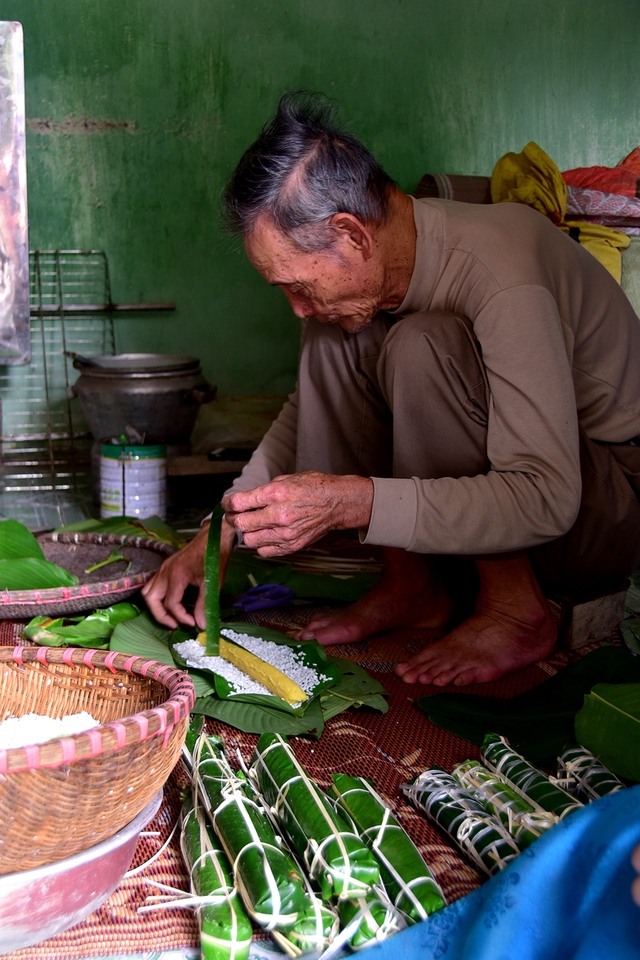
Mr. Ta Dinh Hung, the last banh tay wrapper in Nom village
PHOTO: LAM PHONG
Each time preparing a batch of 100 cakes, it took 2 days, despite his old age and weak health, but Mr. Ta Dinh Hung still tried to do it, because: "The old village custom every time there was a Tet feast or a temple worship, there had to be pork roll, banh tay, cha hoa, all of which were homemade by the villagers, and in more elaborate years, they added braised fish in rice husks. Now those dishes have all been lost, only banh tay remains. Wrapping the cakes is tiring, but the children living far away keep telling them to wrap them for the saints and to bring as a specialty gift from Nom village. In recent years, they have brought banh tay as a Tet gift, and everyone who eats them praises them, so I try to make them to please the children."
Thanks to its small size, evenly wrapped, and 5 hours of boiling in water, the finished banh tay is surprisingly delicious and chewy, and you won't get tired of eating it. Slicing a piece of the cake made by Mr. Hung, you can clearly see the evenly distributed layers of crust, filling, and fat, making you crave it. Eating Mr. Hung's cake is delicious, but there is also a bit of sadness, because the famous banh tay of Nom village is lacking a successor. In many offerings to the saints on spring days of the villagers, the image of banh tay is gradually being replaced by more modern delicacies. I'm worried that one day soon, the banh tay of Nom village will only exist in memories and stories.



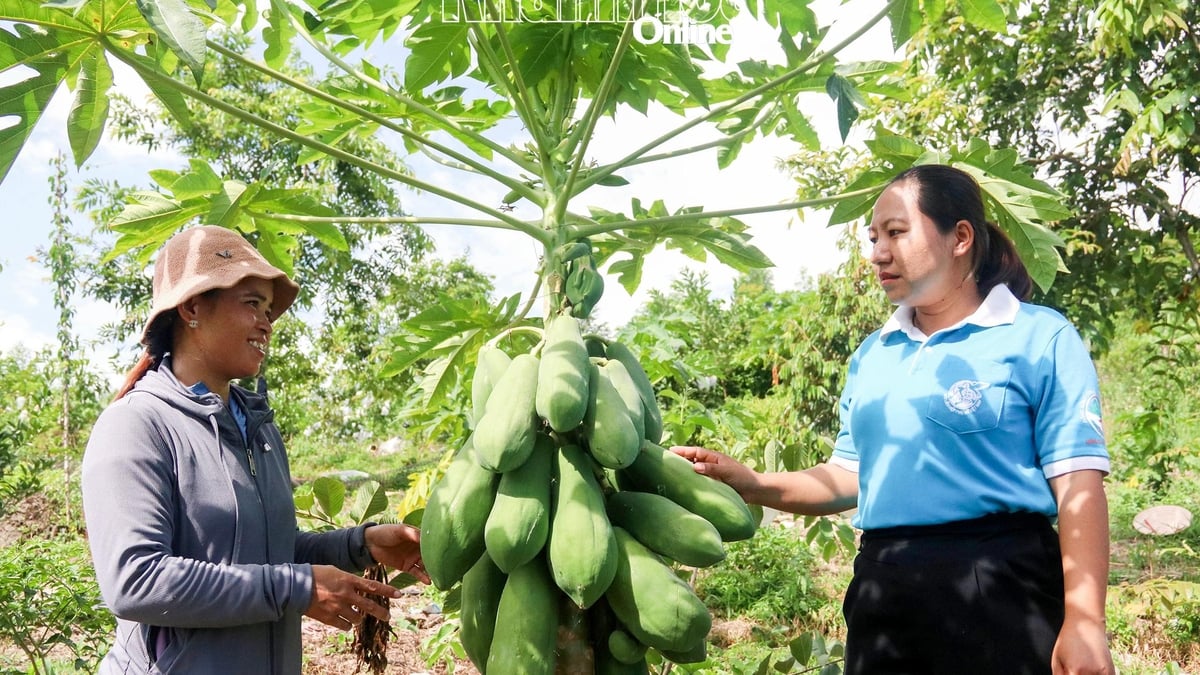


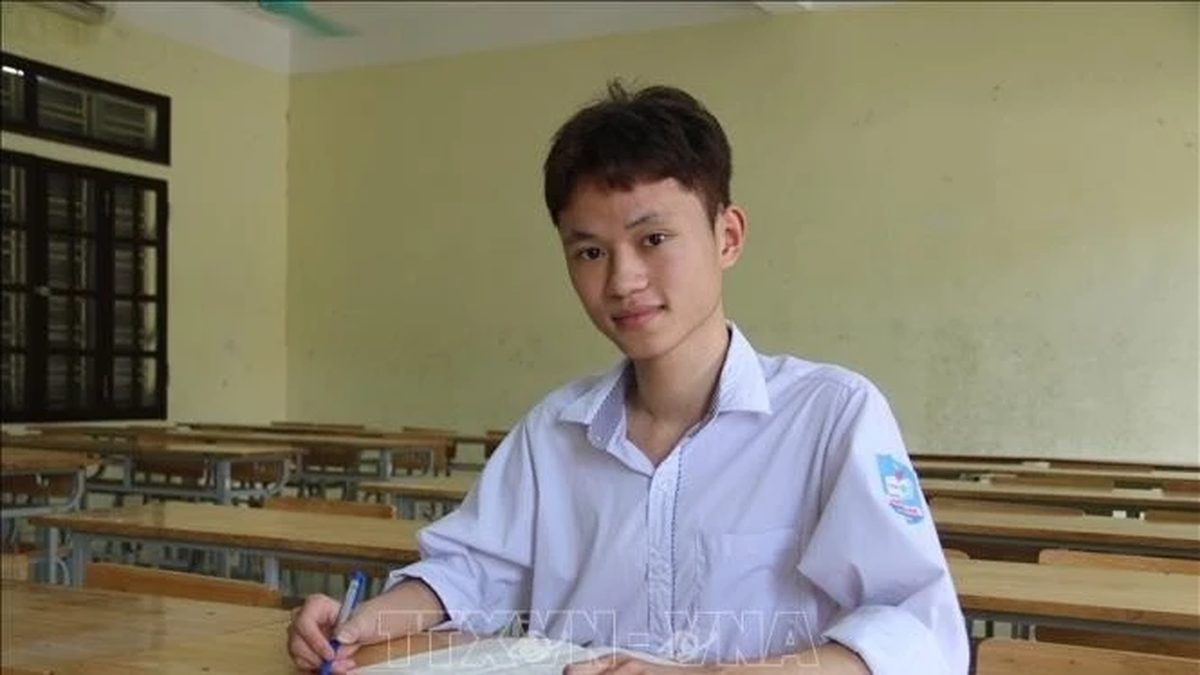













































![[Maritime News] More than 80% of global container shipping capacity is in the hands of MSC and major shipping alliances](https://vphoto.vietnam.vn/thumb/402x226/vietnam/resource/IMAGE/2025/7/16/6b4d586c984b4cbf8c5680352b9eaeb0)













































Comment (0)